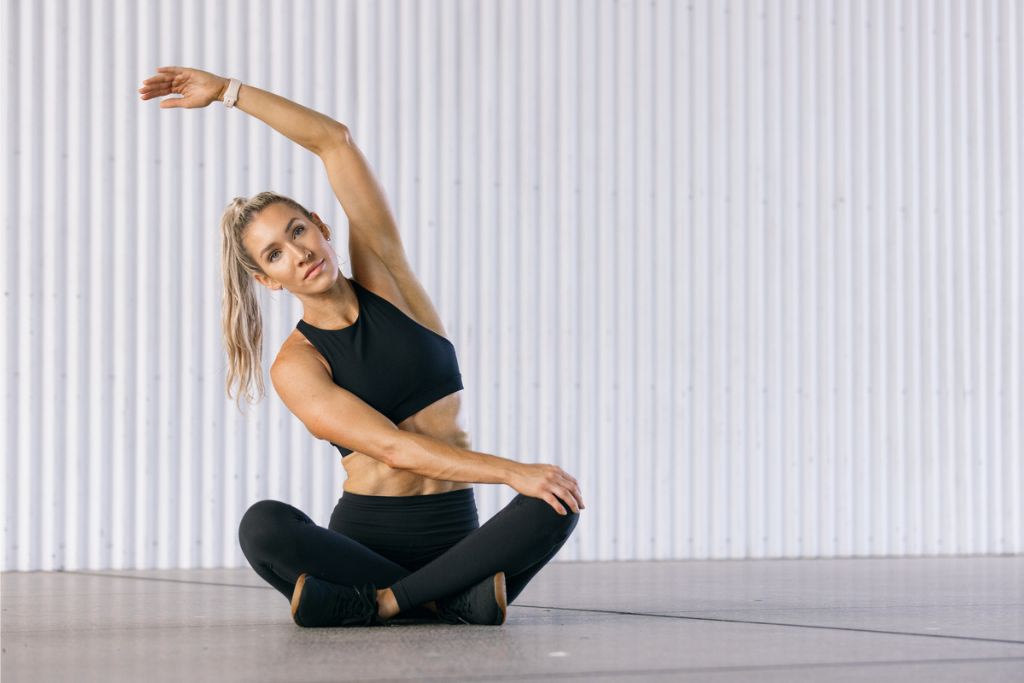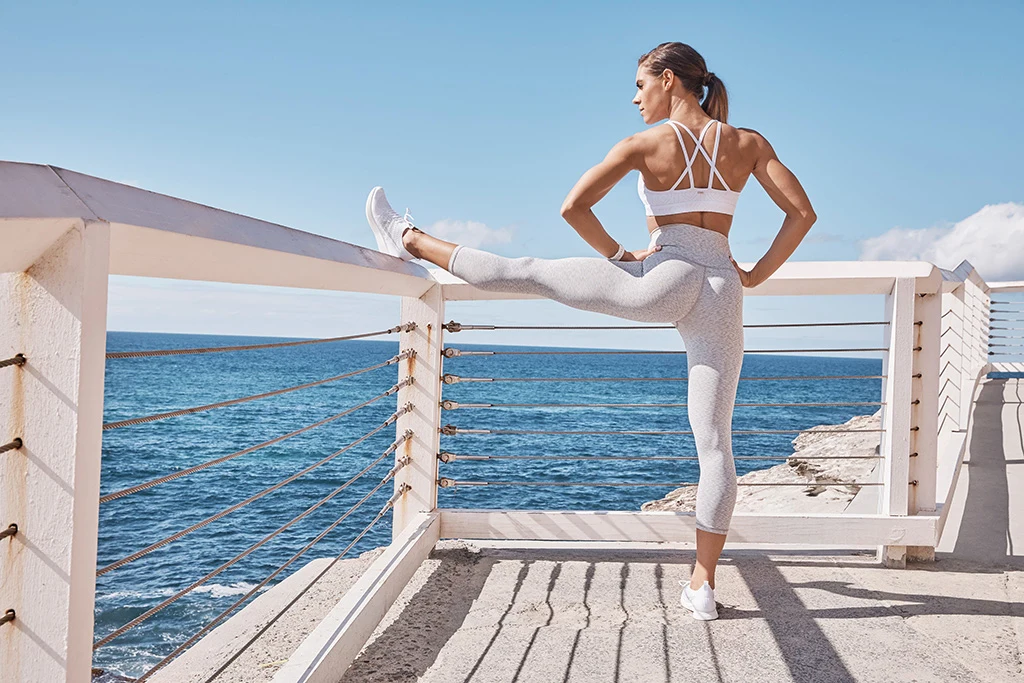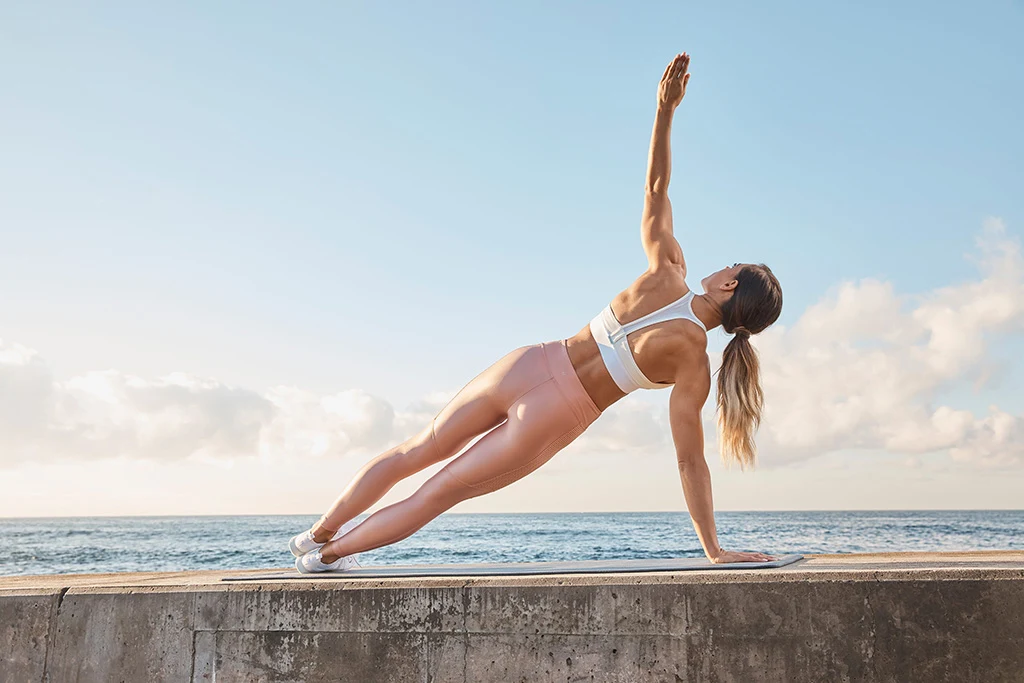Dynamic Stretching: What It Is, Benefits & Examples

February 28, 2020

A good warm-up should be an essential part of every workout, and dynamic stretches are something the trainers in the Sweat app often suggest to prepare your body for the movement to come, but what even are they? With so many workout tips and stretching advice out there, it’s important that we’re clear about what dynamic stretching is — and what it isn’t.
We’ll also explore the benefits of dynamic stretching (there are a few!), how to incorporate it into your routine, and outline examples of dynamic stretching.
What is dynamic stretching?
Dynamic stretching typically takes place before a workout and involves actively moving your muscles and joints through their full range of motion.
This style of stretching aims to increase your reach, optimise your active range of motion, improve blood flow to your tissues and prepare your muscles and tendons to work.
Don’t be fooled by the movement part, a dynamic stretch is still very controlled and won’t get your heart rate up too much - it’s all about warming up and moving through some of the motions that will appear in your workout.

What isn’t dynamic stretching?
Dynamic stretching shouldn't be confused with static stretching, where instead of incorporating continuous movement into your stretch, you hold a stretch position for 20 seconds or more. Static stretching is typically completed after a workout when you’re already warm, as opposed to before.
As Harvard Health explains, performing static stretches before exercise can actually undermine your performance and dynamic stretches are a much better option. Research has also shown that static stretching before activity can lead to a decrease in strength and performance amongst athletes!
Remember, the point isn’t to complete as many dynamic stretches as possible within a specific timeframe or move with intense vigour. Your movements should be controlled and completed at a comfortable pace.
How does dynamic stretching work?
Dynamic stretching works by actively contracting your muscles to move your joints through their full range of motion, thereby increasing blood flow and muscle temperature.
These stretches essentially prime your muscles and connective tissue, preparing your body to work out by activating neuromuscular connections in the working muscles and helping your cells get the oxygen they need for your exercise session.
Who is dynamic stretching good for?
Dynamic stretching is good for… everyone! No matter what your fitness level, age or preferred workout style is, dynamic stretching can be a great way to level up your warm-ups. Depending on your flexibility and mobility, some dynamic stretches might be better options for your body.
When should you use dynamic stretching?
Dynamic stretching is perfect for warming up muscles you will use in your workout to come — that means dynamic stretching is perfect to do before diving into your workout!
Although dynamic stretching is ideal before a workout, it doesn’t mean you can’t do them at other points in the day. In fact, if you have only a short window of time to workout, dynamic stretching is great for targeting specific muscles and getting your heart rate up.
Examples of dynamic stretching
Now that we’ve established what dynamic stretching is (and what it’s not), how it works and who it’s good for, let’s explore some examples you can easily incorporate into your workout routine.
30 SECS
Side lunges
One of the easiest and most accessible dynamic stretches is a side lunge! Side lunges work your quadriceps, glutes and adductors.
Arm circles
That’s right, the humblearm circles are a dynamic stretch. Working your arms, shoulders, chest and back, arm circles are easy to do no matter your level of fitness.
Butt kicks
Get your heart rate up and warm up your quads and leg muscles withbutt kicks.
Leg swings
A fantastic warm-up? Tick. A dynamic stretch? Tick again. These will get your hamstrings going as well as the muscles and joints around your hips.
Walking lunge
A walking lunge is relatively easy to do, and absolutely an example of an effective dynamic stretch! You can also pause at the bottom of the lunge and reach your arm over your head for a nice additional stretch along the side of your torso.
Cat cow
Although traditionally thought of as a yoga pose, the cat cow is a great dynamic stretch to warm up your shoulders, neck and spine.
Benefits of dynamic stretching
When you’re low on time or simply can’t be bothered with a warm-up, these are the benefits of dynamic stretching to keep top of mind. Remember, a good warm-up should always be part of your workout routine.
Dynamic stretching warms up your muscles and can boost performance
We all know we need to warm up before we begin to exercise (especially if it’s a challenging session like HIIT or strength training), and dynamic stretching is the perfect way to do it.
When you warm up your muscles properly, you usually perform better in your workout and feel less stiff. Improved performance? Yes, please.

Dynamic stretching can improve your range of motion and mobility
Research has shown dynamic stretching can improve your range of motion and flexibility while also reducing stiffness.
Whether you’re at the beginning of your fitness journey or a seasoned expert, improved mobility is a huge win.
If you’re scratching your head asking what mobility or range of motion even means, don’t stress. These terms simply refer to the extent to which you have movement of a joint, and dynamic stretching can work wonders by actively moving your muscles and joints to their end range.
If done consistently and with control, it can lead to an improved range of motion, meaning you can get even more out of your workouts.
Dynamic stretching can prevent injuries and assist recovery
If you warm up with some dynamic stretches before launching into exercise, you can significantly reduce your chances of injury — just make sure you’re warming up the muscles you will be using in your training.
Dynamic stretching can also assist muscle recovery by reducing stiffness and promoting better mobility before your next workout.
Get those muscles moving
Let’s recap: dynamic stretching is accessible and so easy to incorporate into your exercise routine, so let’s get those muscles moving!
Regardless of which Sweat program you follow, you can reap the benefits of dynamic stretching.

A more empowered you starts with Sweat, and our editorial team is here to bring you the latest fitness tips, trainer recommendations, wellbeing news, nutritional advice, nourishing recipes and free workouts.
* Disclaimer: This blog post is not intended to replace the advice of a medical professional. The above information should not be used to diagnose, treat, or prevent any disease or medical condition. Please consult your doctor before making any changes to your diet, sleep methods, daily activity, or fitness routine. Sweat assumes no responsibility for any personal injury or damage sustained by any recommendations, opinions, or advice given in this article.
Fitness